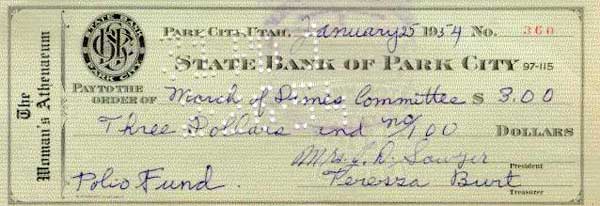At the start of the school year few things are less pleasing to students than receiving vaccinations. Today, Utah law requires specific vaccinations for children entering kindergarten and seventh grade. While vaccinations have been available since the first school was erected in Park City, compulsory immunization for Utah schoolchildren arrived much later.
Public awareness of the availability and benefits of vaccines and inoculations for specific diseases was on the rise in the first half of the 20th century as scientific advancements put forth several new vaccines. Immunization clinics were becoming commonplace in schools across America with Park City’s schools being no exception.
The first three full-scale public schools in Park City – the Lincoln, Jefferson and Washington schools were built in in the late 1800s; the latter of these operates today as the Washington School House Hotel at 543 Park Avenue. The Jefferson was also on Park Avenue while the Lincoln was situated at 1031 Norfolk Avenue. Vaccine clinics were routinely held at the schools. In March 1929 the Park Record reported: “Inoculations, vaccinations, sore arms, and pale countenances are in style at the Lincoln [school] … [where] students were vaccinated or inoculated for small pox, typhoid fever, or diphtheria…”
There were vaccine skeptics back then just as there are now. In Utah, religious and political divides led to a flurry of legislative activity in 1900-1901 with lawmakers ultimately blocking a compulsory vaccine mandate for schoolchildren. Although the Supreme Court of the United States upheld states’ authority to enforce mandatory vaccination laws in 1905, Utah’s law (known as the McMillan Act) would not be overturned until 1933. Frank Parker Stockbridge shared the following view with Park Record readers in 1931: “Vaccination is not pleasant, and there are people who are unhappy when deprived of the privilege of shooting off revolvers at random. Society has to protect the many against the undisciplined few, whether the menace be pistols or smallpox.”
Although vaccine skeptics remained, attitudes and laws governing compulsory vaccines for schoolchildren evolved with time. The Marsac School (now City Hall) was built in 1936 to consolidate elementary and middle school students at a central location after a decline in Park City’s population. By the 1940s attendance at immunization clinics was de rigueur among elementary school students, whereas high school students were less likely to be immunized against diphtheria and smallpox. A 1944 report published in the Park Record both warned and appealed to parents of high schoolers: “The danger from these two diseases is as great among them as among the younger people – parents can you give a word of encouragement to your child and stimulate an interest in this protection?”

Credit: Park City Historical Society & Museum, Woman’s Athenaeum Collection
Following a successful immunization effort in the mid 1940s the Park Record reported that “The Park City high school looked like a zoo. Everyone was walking about like an ape with both arms extended from their sockets.”
By the early 1950s, local students were receiving immunizations for pertussis (whooping cough) and tetanus in addition to smallpox and diphtheria. A polio vaccine would arrive in 1955 following an urgent national effort by citizens and the March of Dimes to fund its development. In the 1960s and 1970s vaccines for measles, mumps, and rubella (German measles) were widely available as well.
Even with a vaccine mandate in place, responsibility for enforcement could be scattershot. An editor of the Park Record in 1949 thought that more responsibility for school vaccines ought to be shifted to parents, stating: “Our schools will do their best to import knowledge, will help with health problems … [but] we shouldn’t leave it all to the schoolteacher. We must do a parent’s share…”
The Park City Museum wishes all students a fantastic new school year! Enjoy it while you can – vaccines and all! And we’ll see some of you on class visits to the Museum!